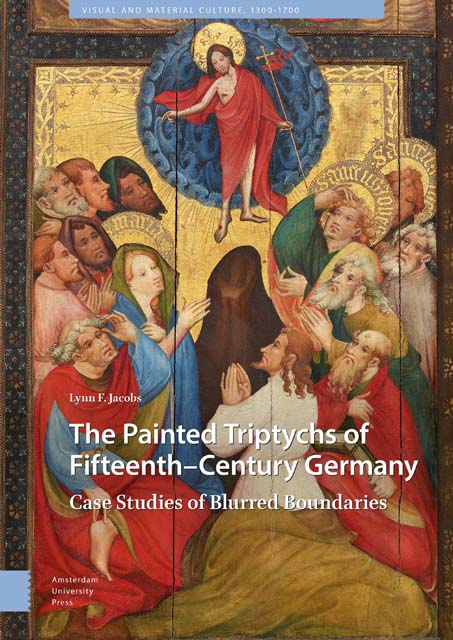Book contents
- Frontmatter
- Dedication
- Table of Contents
- List of Illustrations
- Acknowledgements
- Introduction
- 1 Framed Boundaries: Conrad von Soest and Early Fifteenth-Century Westphalian Triptychs
- 2 Transparent Boundaries: Colour on the Exterior of German Fifteenth-Century Triptychs
- 3 Regional Boundaries : Rogier van der Weyden’s Columba Altarpiece and Cross-Influences Between the Netherlands and Cologne
- 4 Spiritual Boundaries : The Master of the St. Bartholomew Altarpiece and the Border between Reality and Eternity
- 5 Coda: The Triptych in the Age of Dürer
- Bibliography
- Index
3 - Regional Boundaries : Rogier van der Weyden’s Columba Altarpiece and Cross-Influences Between the Netherlands and Cologne
Published online by Cambridge University Press: 16 November 2022
- Frontmatter
- Dedication
- Table of Contents
- List of Illustrations
- Acknowledgements
- Introduction
- 1 Framed Boundaries: Conrad von Soest and Early Fifteenth-Century Westphalian Triptychs
- 2 Transparent Boundaries: Colour on the Exterior of German Fifteenth-Century Triptychs
- 3 Regional Boundaries : Rogier van der Weyden’s Columba Altarpiece and Cross-Influences Between the Netherlands and Cologne
- 4 Spiritual Boundaries : The Master of the St. Bartholomew Altarpiece and the Border between Reality and Eternity
- 5 Coda: The Triptych in the Age of Dürer
- Bibliography
- Index
Summary
Abstract
This chapter studies how the importing of Rogier van der Weyden's Columba Altarpiece into Cologne exposes various directionalities of influences in triptych design between the Netherlands and Cologne. Rogier's triptych adopted the large scale and narrative emphasis of Cologne triptychs, keyed its subjects to Cologne relics, and included motifs and compositional features from Lochner's paintings. Yet this triptych also showcased Netherlandish features not previously seen in Cologne works, notably, highly recessive (rather than gold leaf) backgrounds, full-scale donors, and complex relations between the panels. Despite the presence of Rogier's triptych in their city, Cologne artists maintained local traditions of triptych design, drawing more from Lochner's models than from the Columba Altarpiece, although they were influenced generally by Rogierian style.
Keywords: Rogier van der Weyden, Stefan Lochner, Dombild, Columba Altarpiece, Cologne, relics
Sometime after 1450, an altarpiece by Rogier van der Weyden (Fig. 3.1) was erected in the Church of St. Columba in Cologne. This was an important event because it brought a major, large-scale work by one of the most famous artists from the Southern Netherlands into a prestigious church located in one of the wealthiest and most prominent towns of late medieval Germany. This was not the first Netherlandish triptych to arrive in Cologne: the Werl Triptych, a work commissioned from Tournai by the Franciscan Heinrich von Werl, provincial of the Cologne province of Minorites, was painted in 1438, either by Robert Campin, Rogier van der Weyden, by both artists, or by Rogier's workshop and likely placed in one of Cologne's Minorite churches. But this work—which has lost its central panel and presently consists only of a donor wing and a wing with St. Barbara reading—had little impact on art in Cologne, perhaps due to its smaller size and possibly inaccessible location; nor was its design, as far as one can tell, impacted by its Cologne patronage and destination. By contrast, Rogier's Columba Altarpiece, produced about a decade later, engaged in a far-ranging dialogue with Cologne artistic traditions.
Rogier's Columba Altarpiece depicts the Annunciation on the left panel, the Adoration of the Magi in the centre, and the Presentation in the Temple at the right.
- Type
- Chapter
- Information
- The Painted Triptychs of Fifteenth-Century GermanyCase Studies of Blurred Boundaries, pp. 165 - 208Publisher: Amsterdam University PressPrint publication year: 2022



